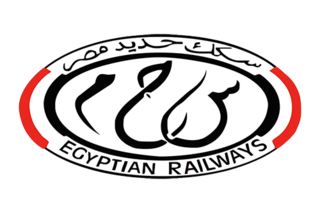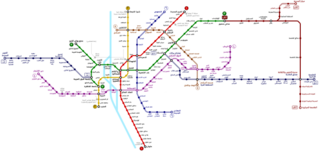Transport in Egypt is centered in Cairo and largely follows the pattern of settlement along the Nile. The Ministry of Transportation and other government bodies are responsible for transportation in Egypt, whether by sea, river, land or air.

Cairo Governorate is one of the 27 governorates of Egypt. It is formed of the city of Cairo, both the national capital of Egypt and the governorate's, in addition to five satellite cities: the New Administrative Capital - set to become the seat of national government, New Cairo, Shourok, Badr, Capital Gardens, and 15th of May. These cities form almost half of the Greater Cairo metropolitan area by population.

The Cairo Metro is the rapid transit system in Greater Cairo, Egypt. It was the first of the three full-fledged metro systems in Africa and the first in the Middle East to be constructed. It was opened in 1987 as Line 1 from Helwan to Ramses Square with a length of 29 kilometres (18.0 mi). As of 2013, the metro carried nearly 4 million passengers per day. As of May 2024, the Cairo Metro has 84 stations of which 5 are transfer stations, with a total length of 100.1 kilometres (62.2 mi). The system consists of three operational lines numbered 1 to 3.

Maadi is a leafy and once suburban district in the Southern Area of Cairo, Egypt, on the east bank of the Nile about 12 kilometers (7.5 mi) upriver from downtown Cairo. The modern extensions north east and east of Maadi, New Maadi and Zahraa al-Maadi are administratively part of the Basatin district.

Ramses Railway Station, also called Misr Station, is the main railway station of Cairo, Egypt. The name is derived from the Ancient Egyptian pharaoh Ramses II, whose statue was erected by Nasser on the square there in 1955.
Transport in Cairo comprises an extensive road network, rail system, subway system and maritime services for the more than 15.2 million inhabitants of the city. Cairo is the hub of almost the entire Egyptian transport network.

Egyptian National Railways is the national railway of Egypt and managed by the parastatal Egyptian Railway Authority.

The Alexandria tramway network serves the city of Alexandria, Egypt. It began operating in 1863 and consists of 20 lines operating on 32 kilometers (20 mi) of the track, serving 140 stops. It is one of only a few tram systems in the world that uses double-deck cars; other examples are Blackpool in the UK and Hong Kong. The system is a 1,435 mmstandard gauge.

The 6th of October Bridge is an elevated highway in Cairo, the capital city of Egypt. The 20.5-kilometre (12.7 mi) bridge and causeway crosses the Nile twice from the western bank suburbs, east through Gezira Island to Downtown Cairo, and on to connect the city to other highways that lead to the Cairo International Airport to the east.
El-Marg is a station on the Cairo Metro that is located at El-Marg district in north east Cairo, Egypt. It is on Line 1 and is an above ground station.

Cairo Metro Line 2 is the second line of the Cairo Metro in Cairo, Egypt.
Cairo Metro Line 3 is a main east-west line of the Cairo Metro rapid transit system in Greater Cairo, Egypt. It has a length of 34.2 km (21.3 mi) with 34 stations, all built and operated in seven phases between 2007 and 2024.

The Buenos Aires Metrobús is a 50.5 km (31.4 mi) network of dedicated separated lanes and stations for buses that serve the city of Buenos Aires, Argentina. Designed as a Bus Rapid Transit system, it mixes a few bi-articulated buses with conventional buses. The headway is the same as before the implementation of the system, and the buses on the system use the same brand as the main network, that is, maintaining their previous branding as common bus lines with their own numbers. The service operates 24 hours a day and 365 days a year, with 2-4 minute frequencies during the day and 10–15 minutes at night.
The Suez Canal Corridor Area Project is a megaproject in Egypt that was launched on 5 August 2014 by President Abdel Fattah el-Sisi and was completed in 2015. The project aimed to increase the role of the Suez Canal region in international trade and to develop the canal cities of Suez, Ismailia, and Port Said.

The following outline is provided as an overview of and topical guide to Cairo:
The Alexandria Metro is a proposed rapid transit system for Egypt's second largest city, Alexandria. It will be Egypt's second metro system after the Cairo Metro.
The Cairo Monorail is a two-line monorail rapid transit system currently under construction in Cairo and is projected to become the longest driverless monorail system in the world. The two lines will create the first public transport from the New Administrative Capital and 6th of October City to the Cairo metropolitan area when completed. The expected travel time for the 53km Line between the New Administrative City and East Cairo is about 60 minutes and the 42km line connecting 6th of October City with Giza is about 42 minutes.

The Cairo Light Rail Transit or Cairo LRT is an electrified regional rail system linking the city of Cairo to Egypt's New Administrative Capital and the 10th of Ramadan City. An initial 70 km route consisting of 12 stations was inaugurated on 3 July 2022.














